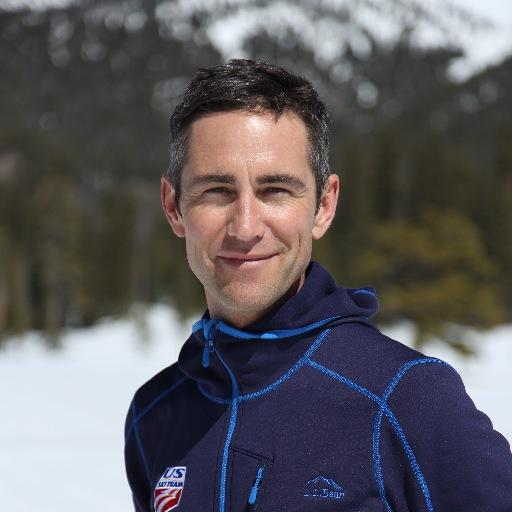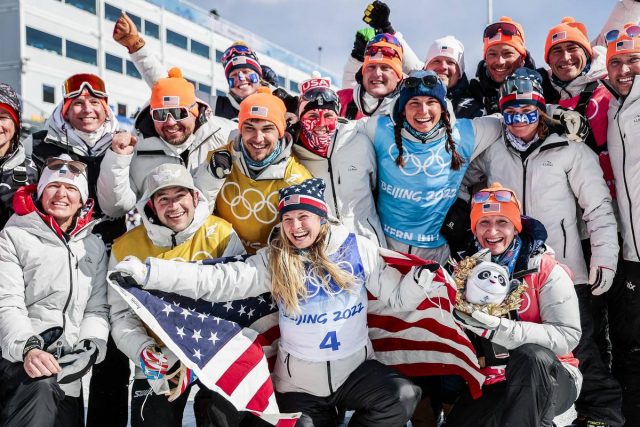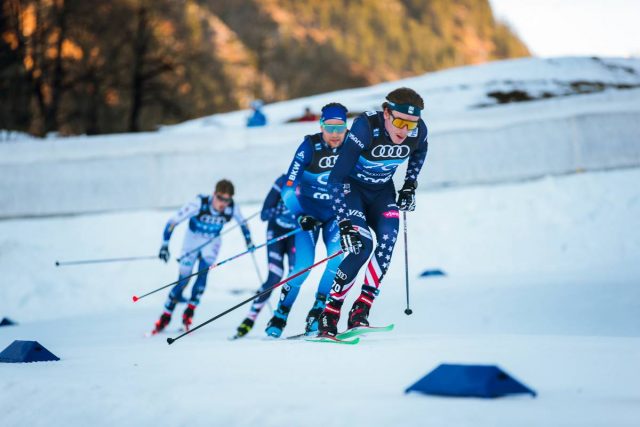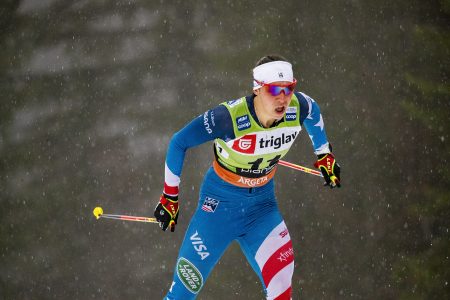
Chris Grover is the U.S. Cross-Country Program Director, a position he’s held for three years. He sat down with FasterSkier’s Ken Roth to discuss the upcoming World Cup season, and an overview of the U.S. program.
What exactly is the job of Program Director?
I oversee all aspects of the program for team development, coaches’ education, events, budgets, selection criteria, and all other staff. This includes technicians, volunteer physical therapist, volunteer doctors, sports psychologist, and skiers. We have six full time staff, plus skiers. We have six World Cup technicians who are seasonal, plus three part time contract employees who work domestically. We’re relatively small, so all of us coaches have to be able to do everything. I go with the team to Europe and travel back and forth to home a little bit.
That’s a surprisingly small number of full-time staff. How does that compare to Norway and other countries? How are you able to get everything done with such a small full-time staff?
It’s hard to compare ourselves to Norway in that they are lightyears ahead in terms of size and budget. Their budget is probably ten times ours. For example, they have 98 athletes on their team (national and regional) compared to our 22 (A, B, and D teams). Russia, Sweden, and Finland are all larger as well. We are similar in size to many Central European nations like Italy, France, and Germany. But, some of those countries have connections with the military, police force, or border guard which gives them additional support.
What are other challenges the U.S. team faces compared to the Europeans?
One of our big challenges is that our cost to compete in Winter is high, because our team never really goes home. We’re on the road nonstop. The Europeans save money because during the week they’re living at home. They will arrive just before the weekend and leave after the weekend. This savings allows them to invest in extra staff. We don’t have the same resources for coaching.
You have a lot of volunteer staff and part time staff while in Europe?
We rely 100 percent on volunteer physicians to travel with us. Most of the physical therapist and massage therapist are volunteers. The volunteers are literally taking their own vacation time to be with us. In the case of the physicians, they’re even paying their own way! It’s an incredible gift. We only have one person on our medical team who is not a volunteer. All our technicians are seasonal employees.
What does it take to get the team to Europe and compete nonstop for four months? What supports are in place for the athletes?
It’s a huge task. The real change for us is that the size of the program has grown in the last 15 years. In 2006, we’d have six staff and maybe seven to eight athletes. Now we have 16 to 20 athletes, with 11 to 15 staff. So, the logistics have really grown. We’re going to start this year with 16 athletes and have about 15 staff for each World Cup start. Most of those are technicians and a few coaches. We also have a physical therapist, a doctor, a strength and conditioning coach, and sometimes a sports psychologist. This year we’ll also have a coach from the Trail to Gold Fellowship (a program through the National Nordic Foundation which provides promising women coaches in the United States the opportunity to gain international-level coaching experience at the World Cup).
How do you help the athlete’s maintain intensity during this long period on the road?
We work with sports psychologist which the athletes have access to. That’s a key support mechanism. It’s very individual also. Our veteran athletes have figured out what works for them. For some that’s coming back to the U.S. during the middle of the season. Others stay in Europe and bring family over, which has been really challenging during Covid. Hopefully this year will be more normal.
We also create more family style living situations on the road rather than being in hotels. It’s really important psychologically. It also helps us to improve the food we eat.
But, it’s a huge disadvantage for non-European nations. Everyone else gets to go home to recharge, but we can’t.

The women’s team is well known for its team dynamics and team culture. Do you try to develop team leadership and team dynamics, or do you let it develop organically?
A little of both, depending who’s on the team in a given year. We don’t have team Captains, and that’s on purpose. We try and create an atmosphere where everyone can lead at times. Everybody’s good at something, we need to bring that out. We’ve had an incredible women’s team culture at times. Sometimes we’ve had to work to maintain it.
Right now we also have an incredible men’s team culture driven by this younger generation that’s been entering the national team that’s had a lot of success at the world Junior level. The current group are great friends and training partners who want to see each other succeed. So then it’s more about maintaining what you have rather than trying to create something.

The men have gained experience. Are they at the point where they can now maximize their potential?
Last year, for a lot of them, it was their first time for a lot of venues. Of the six men at the Olympics, five were first time Olympians. They are just coming into their own. The future is very bright.
So the men still need more experience?
For sure. They’re still growing, still learning, still building their training bases. Many of them are still finishing school. Some are still NCAA racing, and a majority are still U23 (under 23 years old). Many will take time off from World Cup to come back for the U23 championships in Whistler (British Columbia).
The Tour de Ski, which is in the middle of the season, requires enormous energy expenditure. Do you plan in advance how to manage the Tour de Ski, or do athletes and coaches wait until they are in it and see how they are doing?
It’s individual; and the U.S. is a little different. Individual athletes are primarily coached by the individual coaches or club coaches, except for Jessie Diggins. We do that because they spend the vast majority of time with those coaches. We only held three training camps this summer and fall.
Within that system there are lots of individual plans. The national team staff helps to advise the best way to manage planning. Of the 22 different athletes, there will be 22 different plans.
This year FIS (International Ski and Snowboard Federation) has added a weekend off prior to the Tour and weekend off following the Tour. So that will help. FIS is trying to encourage all of the superstars to be at all of the races, so they’re trying to build in better breaks.
Some athletes will wait and see how the first few weeks of World Cup are going. I think there will be a big group of athletes who go home after the tour.
With only three training camps what’s the opportunity for being on snow in the off season?
We had a training camp in May at Mt. Batchelor, which is a great on snow camp. We had a couple of other opportunities in Australia and in a ski tunnel. A big challenge is that Eagle Glacier (Alaska) has been closed for three years. A number of our Alaskan athletes would use it, so losing it is a big challenge.
Also, the New Zealand snow farm might be permanently shut down, and we have been using that facility forever. That’s a huge loss. Also, diminishing snowpacks on European glaciers is a problem. On snow opportunities are drying up.
We generally prefer to avoid the tunnels. They’re only 1.2 k and you get bored easily. It’s way nicer to be outdoors. You can’t do week after week in a tunnel like you can outdoors.

The World Championships will be held for the first time in Planica, Slovenia. Do you need to scout it, or are you familiar enough with it? Any specific training changes in a World Championship year?
No, we don’t need to scout it. We’ve been there many times. I’ve been there going back to 2001. We have done a lot of sprints there, not as much distance racing. But we’ve done some distance racing there over the years, having raced on the primary distance course. It’s a compact set of courses, and typically not a ton of snow. It’s likely to be a 5k loop for most races.
We have a good situation going into it. We’re going to live in Italy, just over the border.
In terms of preparation, it’s not high altitude, so its manageable. Being in the end of February, early March, I expect warmer conditions. So, strategies to keep racers cool will have to be used, like we have in the past two World Championships. We start preparing for warmer conditions during the summer. Jessie in particular has done work with this; but I can’t go into the details.
It will be a battle to figure out ski structure if we have sloppy, wet, dirty snow conditions. Fingers crossed for more traditional winter temperatures.
Any goals you can share for this season?
For Jessie and Rosie, both are focused on spending the entire year in Europe. This will be different for Rosie compared to last year. Both are hyper focused on pursuing the overall World Cup and the World Championships.
On the men’s side, the younger guys want to go to U23 championships. They see it as a great opportunity being in Whistler. It’s a bit of home advantage. A lot of the focus of the year will be on that. Beyond that, it’s making incremental steps on the World Cup and World Championships.
How did athletes adapt to not having fans the last two years?
For the most part, everyone missed the fans. The atmosphere suffered without fans. It’s been really nice to see fans returning.
Stay tuned for Part II of Fastskier’s interview with Chris Grover. In the next segment, we’ll talk about the Russian ban, equal distances for genders, and fluoros, among other thing



